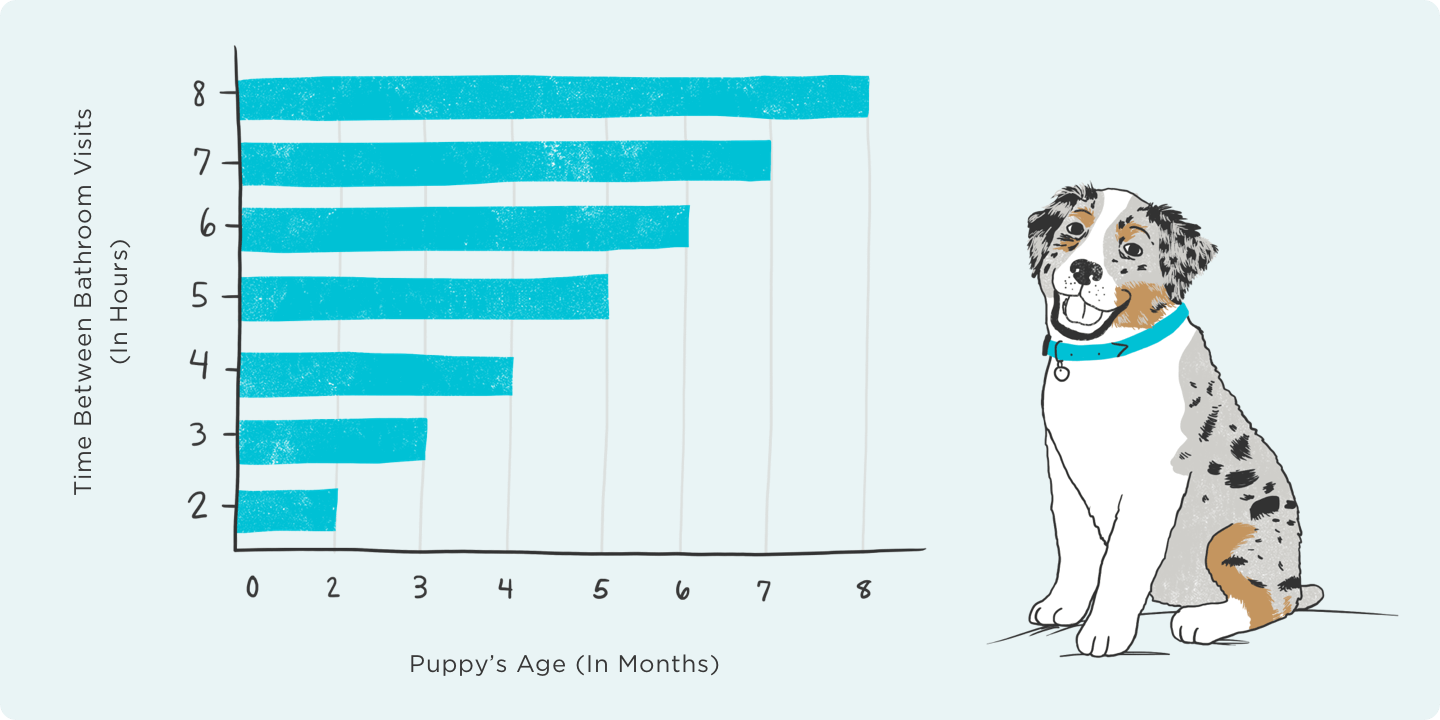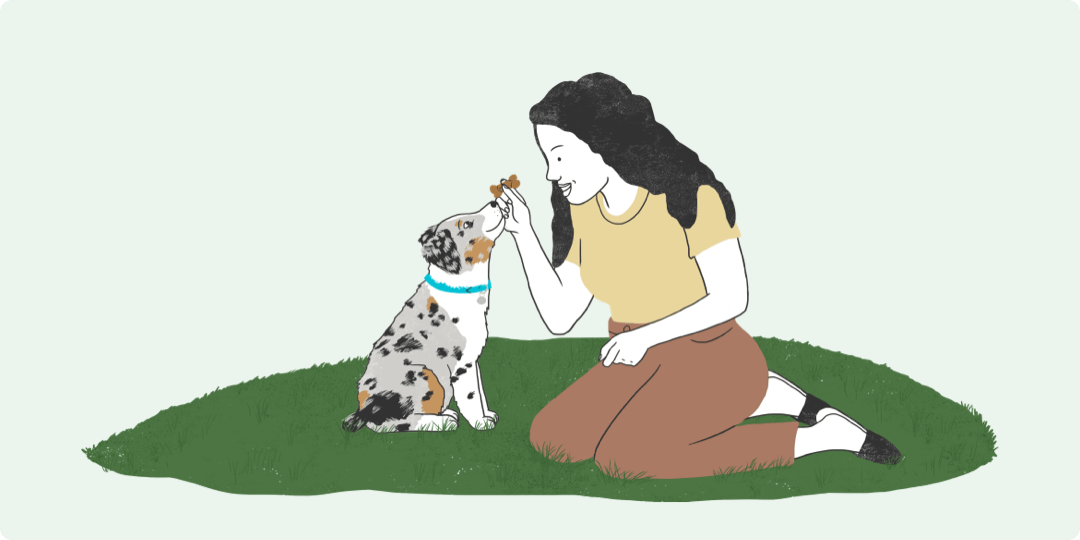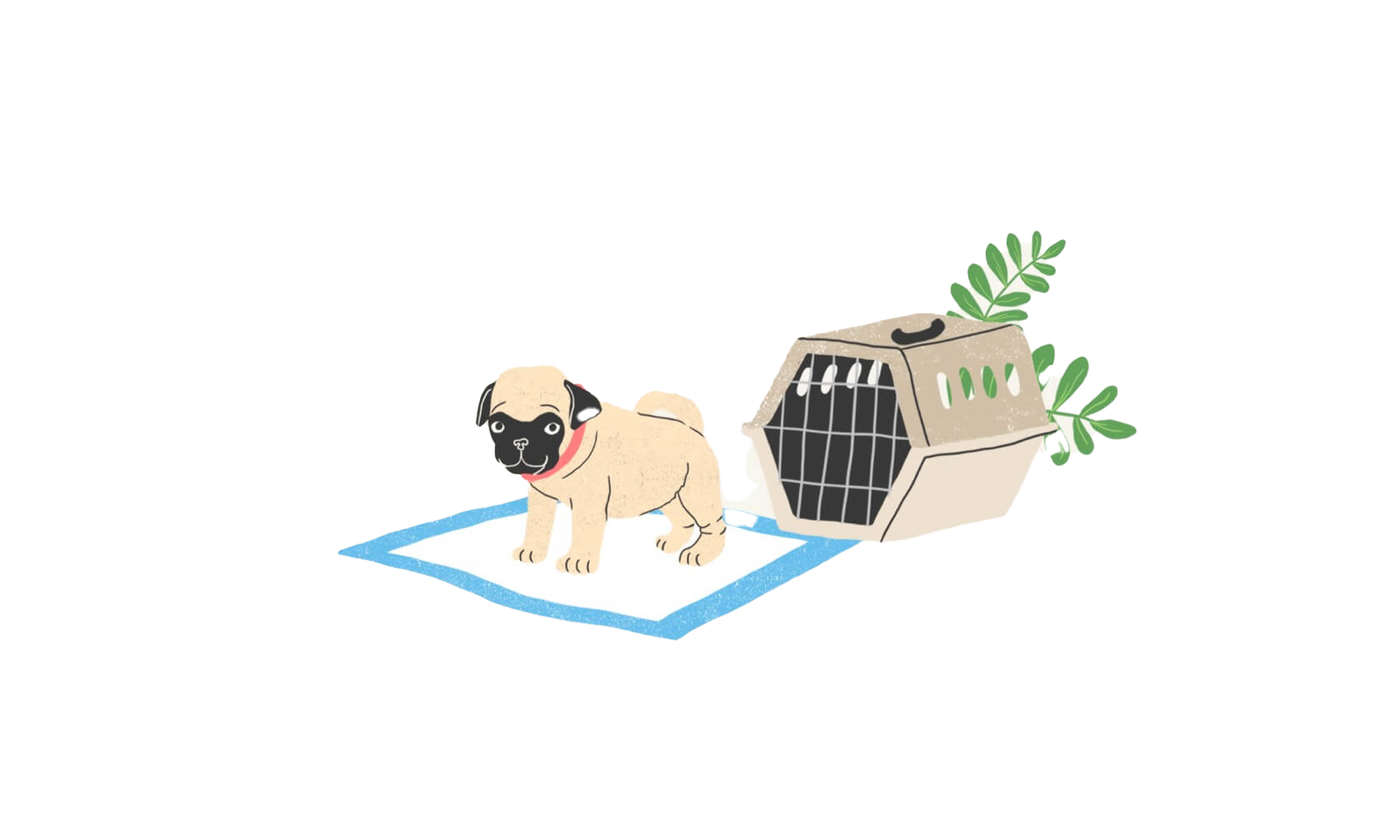No one enjoys cleaning up indoor potty accidents. Teaching a new puppy to go potty outside is important for a lifetime of proper bathroom manners. It’s important to remember that your new puppy doesn’t know where they should or shouldn’t go potty — it’s up to us to teach them that outside (or on a designated puppy potty pad) is the right place. You can potty train your puppy quickly and successfully with some planning, lots of patience, and consistent positive rewards when they get it right.
Create a Potty Training Schedule
Provide regular and consistent outside potty breaks for your puppy (or take them to a potty pad). This way, you’ll have more opportunities to reward them when they go in the right spot and you’ll prevent indoor potty accidents.
As a guideline, the maximum time between potty breaks for your dog should be one hour for each month of age (and even more frequently if just starting potty training):

All dogs, no matter what their age, should be given a bathroom break at least every 8 hours.
The younger the puppy, the more frequent these breaks should be. Their physical ability to hold it is still developing. Start with giving them the opportunity to potty outside at least once every two hours during the day (as well as after any activity listed below). As they mature and learn the routine, you’ll extend the time between scheduled potty breaks.
Take your puppy outside for a potty break after the following events:
- Waking up (first thing in the morning or after any naps)
- After drinking water
- 10-15 minutes after eating
- After playtime
- After training
- Before going to sleep at night
- Between any change in activity
If your puppy is having multiple indoor potty accidents, consider adding more potty breaks to the schedule. Frequent indoor potty accidents could also be a sign of an underlying medical condition. Speak with your veterinarian to determine if your puppy might be having accidents due to a medical issue.
Supervise Your Puppy to Set Them up for Success
Potty accidents often happen when signs that a puppy needs to go to the bathroom go unnoticed. Until your puppy is more physically mature and reliably housetrained, it’s best to keep a close eye on them. If you notice signs they might need to go to the bathroom, take them immediately outside to their regular potty spot.
Signs Your Puppy Might Need to Go Potty:
- Sniffing the floor
- Turning in circles
- Pacing
- Whining
- Restless behavior
- Licking their groin
- Arching their back or squatting
- Suddenly stopping what they're doing (such as chewing on a toy or playing)
- Leaving the room or seeking out a place to go potty that's more hidden
- Sitting by the door
When you can’t supervise your puppy, use crate training to prevent potty accidents. Using a correctly sized crate helps a puppy learn how to physically hold it, as they do not want to go to the bathroom where they sleep. Ensure that your puppy isn't in their crate so long that they have an accident because they couldn't hold it any longer. As always, make sure that being in the crate is a positive and comfortable experience for your puppy.
Reward Your Puppy for Going Potty Outside
Any time your puppy goes potty outside, reward them with a treat and lots of praise! The more you reward a behavior, the more your puppy will choose to do it. Combining positive reinforcement with proper management of their environment (frequent potty breaks and supervision) will lead to successful potty training faster. Negative reinforcement for potty accidents is never appropriate and should not be used.

Keep Regular Feeding Times
Eating a meal or snack sends signals to your puppy’s digestive system that it needs to empty to make room for incoming food. This is called the gastrocolic reflex and is why puppies will often need to go potty after eating a meal. Keep your puppy on a set feeding schedule for breakfast, lunch, and dinner so you can anticipate when they will need to go potty.
Consider whether you want your puppy to have access to water overnight in their crate. Unless your puppy has a medical condition requiring access to water at all times, you can remove their water an hour before bedtime. This ensures your puppy’s bladder is empty before going to sleep, reducing the chance that they’ll need to go potty in the middle of the night. Because water is essential to your puppy’s physical health, make sure they have access to it again first thing in the morning.
How Long Does it Take to Potty Train a Puppy?
Every dog is different when it comes to potty training. Some puppies might be reliably housetrained by four to five months of age, while others might be closer to seven or eight months before getting the hang of it. In some cases, a medical issue might cause a setback in house training. Most importantly, the time it takes to potty train your puppy depends on your consistent training and management.
When Should You Start Potty Training a Puppy?
Begin potty training your puppy right away! The sooner your puppy learns the routine, the faster they will learn correct housetraining habits.
What Is the Hardest Breed to Potty Train?
It’s impossible to say that one breed is better or worse than others, as potty training depends on a consistent home setup and training schedule. However, in some cases, toy breeds or smaller breeds of dogs might take longer to potty train simply due to their size. Because their bladders are quite tiny, they need more frequent potty breaks to prevent accidents. Often, these breeds have indoor accidents simply because they couldn’t hold it as long as a larger breed might be able to.
ZPC-00812R2



